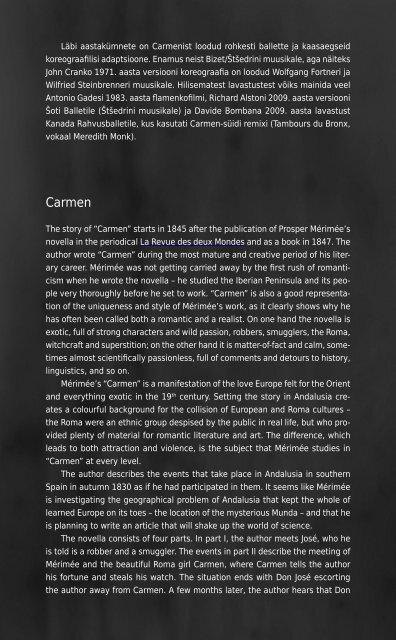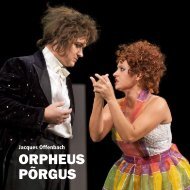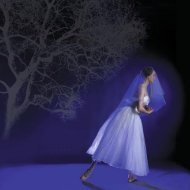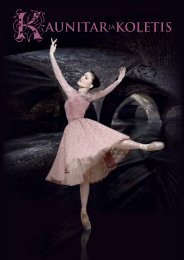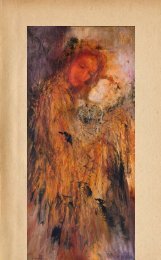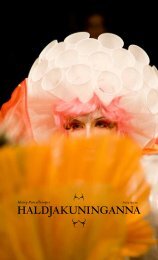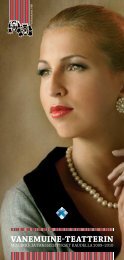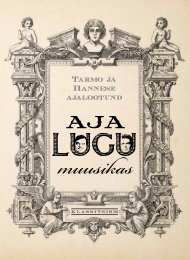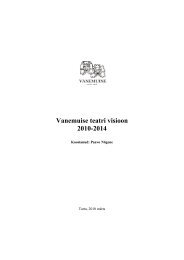tantsulavastus - Vanemuine
tantsulavastus - Vanemuine
tantsulavastus - Vanemuine
You also want an ePaper? Increase the reach of your titles
YUMPU automatically turns print PDFs into web optimized ePapers that Google loves.
Läbi aastakümnete on Carmenist loodud rohkesti ballette ja kaasaegseid<br />
koreograafilisi adaptsioone. Enamus neist Bizet/Štšedrini muusikale, aga näiteks<br />
John Cranko 1971. aasta versiooni koreograafia on loodud Wolfgang Fortneri ja<br />
Wilfried Steinbrenneri muusikale. Hilisematest lavastustest võiks mainida veel<br />
Antonio Gadesi 1983. aasta flamenkofilmi, Richard Alstoni 2009. aasta versiooni<br />
Šoti Balletile (Štšedrini muusikale) ja Davide Bombana 2009. aasta lavastust<br />
Kanada Rahvusballetile, kus kasutati Carmen-süidi remixi (Tambours du Bronx,<br />
vokaal Meredith Monk).<br />
Carmen<br />
The story of “Carmen” starts in 1845 after the publication of Prosper Mérimée’s<br />
novella in the periodical La Revue des deux Mondes and as a book in 1847. The<br />
author wrote “Carmen” during the most mature and creative period of his literary<br />
career. Mérimée was not getting carried away by the first rush of romanticism<br />
when he wrote the novella – he studied the Iberian Peninsula and its people<br />
very thoroughly before he set to work. “Carmen” is also a good representation<br />
of the uniqueness and style of Mérimée’s work, as it clearly shows why he<br />
has often been called both a romantic and a realist. On one hand the novella is<br />
exotic, full of strong characters and wild passion, robbers, smugglers, the Roma,<br />
witchcraft and superstition; on the other hand it is matter-of-fact and calm, sometimes<br />
almost scientifically passionless, full of comments and detours to history,<br />
linguistics, and so on.<br />
Mérimée’s “Carmen” is a manifestation of the love Europe felt for the Orient<br />
and everything exotic in the 19th century. Setting the story in Andalusia creates<br />
a colourful background for the collision of European and Roma cultures –<br />
the Roma were an ethnic group despised by the public in real life, but who provided<br />
plenty of material for romantic literature and art. The difference, which<br />
leads to both attraction and violence, is the subject that Mérimée studies in<br />
“Carmen” at every level.<br />
The author describes the events that take place in Andalusia in southern<br />
Spain in autumn 1830 as if he had participated in them. It seems like Mérimée<br />
is investigating the geographical problem of Andalusia that kept the whole of<br />
learned Europe on its toes – the location of the mysterious Munda – and that he<br />
is planning to write an article that will shake up the world of science.<br />
The novella consists of four parts. In part I, the author meets José, who he<br />
is told is a robber and a smuggler. The events in part II describe the meeting of<br />
Mérimée and the beautiful Roma girl Carmen, where Carmen tells the author<br />
his fortune and steals his watch. The situation ends with Don José escorting<br />
the author away from Carmen. A few months later, the author hears that Don


